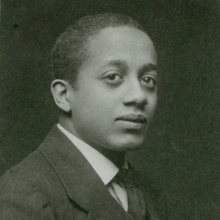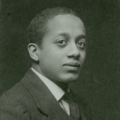Alain LeRoy Locke para niños
Datos para niños Alain LeRoy Locke |
||
|---|---|---|
 |
||
| Información personal | ||
| Nacimiento | 13 de septiembre de 1885 Pensilvania (Estados Unidos) o Filadelfia (Estados Unidos) |
|
| Fallecimiento | 9 de junio de 1954 Nueva York (Estados Unidos) |
|
| Sepultura | Congressional Cemetery | |
| Nacionalidad | Estadounidense | |
| Religión | Bahaísmo | |
| Familia | ||
| Padres | Pliny Ishmael Locke Mary Locke |
|
| Educación | ||
| Educado en | Harvard University | |
| Información profesional | ||
| Ocupación | escritor, filósofo, educador, y patrono de las artes | |
| Empleador | Universidad Howard | |
| Movimiento | Renacimiento de Harlem | |
| Lengua literaria | inglés | |
| Miembro de |
|
|
| Distinciones |
|
|
Alain LeRoy Locke (nacido en Filadelfia, Pensilvania, el 13 de septiembre de 1885, y fallecido en Nueva York el 9 de junio de 1954) fue un importante escritor, filósofo, educador y promotor del arte en Estados Unidos. Es recordado por su gran influencia en el Renacimiento de Harlem, un periodo de gran florecimiento cultural.
En 1907, Alain Locke hizo historia al ser el primer afroamericano en recibir una beca Rhodes. Esta beca le permitió estudiar en la prestigiosa Universidad de Oxford en Inglaterra. Su trabajo fue tan significativo que se le considera el "arquitecto filosófico" del Renacimiento de Harlem. Este movimiento cultural, que ocurrió entre 1919 y 1934, impulsó la creatividad y el orgullo en la comunidad afroamericana.
Locke fue el editor invitado de una edición especial de la revista The Survey Graphic en 1925, titulada «Harlem, la meca del “New Negro”». Más tarde, amplió este trabajo en su famosa antología The New Negro: An Interpretation, publicada en diciembre de 1925. Este libro se convirtió en un hito en la literatura afroamericana. El 19 de marzo de 1968, Martin Luther King Jr. reconoció la importancia de Locke, diciendo: "Vamos a dejar que nuestros niños sepan que Platón y Aristóteles no fueron los únicos filósofos que vivieron, también W. E. B. Du Bois y Alain Locke vivieron en el universo."
Contenido
¿Quién fue Alain Locke?
Alain Locke nació en Filadelfia, Pensilvania, el 13 de septiembre de 1885. Sus padres fueron Pliny Ishmael Locke y Mary Hawkins Locke. Desde joven, mostró un gran interés por el estudio y el conocimiento.
Educación y primeros logros
Locke se graduó de la Central High School en Filadelfia en 1902. Luego, continuó sus estudios en la Escuela de Pedagogía de Filadelfia.
En 1907, se graduó de la Universidad de Harvard con títulos en inglés y filosofía. Fue en este año cuando recibió la histórica beca Rhodes. Aunque algunos colegios en Oxford le negaron la entrada debido a su raza, finalmente fue aceptado en el Hertford College. Allí, entre 1907 y 1910, estudió literatura, filosofía, griego y latín. Después, en 1910, estudió filosofía en la Universidad de Berlín.
Locke se convirtió en profesor asistente de inglés en la Universidad Howard en Washington D. C.
Regreso a Harvard y doctorado
En 1916, Locke regresó a Harvard para trabajar en su tesis de doctorado. Su tesis se tituló El problema de la clasificación en la Teoría del Valor. En ella, exploró cómo las opiniones y los puntos de vista sociales no son siempre objetivos ni universales. Obtuvo su doctorado en filosofía en 1918.
Después de obtener su doctorado, Locke regresó a la Universidad Howard. Allí, se convirtió en el jefe del departamento de filosofía, un puesto que mantuvo hasta su jubilación en 1953.
El Renacimiento de Harlem y la filosofía del "New Negro"
Alain Locke fue una figura central en el Renacimiento de Harlem. Animó a los artistas, escritores y músicos afroamericanos a buscar inspiración en la cultura de África y en su propia historia. Les instó a crear obras que reflejaran temas africanos y afroamericanos, celebrando su herencia.
La revista Survey Graphic y The New Negro
En marzo de 1925, Locke editó un número especial del periódico Survey Graphic. Este número se centró en Harlem y el Renacimiento de Harlem, ayudando a educar a un público más amplio sobre esta cultura en crecimiento.
Más tarde, expandió este trabajo en su libro The New Negro, una colección de escritos de autores afroamericanos. Este libro se convirtió en una de sus obras más conocidas y un referente cultural.
La idea del "New Negro"
La filosofía de Locke sobre el "New Negro" se basaba en la idea del desarrollo y el progreso de la comunidad afroamericana. El punto más importante de esta idea era la conciencia sobre el potencial de la igualdad. Locke creía que las personas afroamericanas ya no debían aceptar imposiciones injustas. Esta idea se basaba en la confianza en uno mismo y en la conciencia política.
Locke sostenía que, aunque en el pasado las leyes de igualdad a menudo se ignoraban, la filosofía del "New Negro" exigía un trato justo. Como esta era una idea y no solo una ley, su poder residía en las personas. Si querían que esta idea se hiciera realidad, debían "imponerla" a través de sus acciones y puntos de vista. Se dice que Locke influyó mucho en la escritora Zora Neale Hurston.
Legado de Alain Locke
El impacto de Alain Locke en la educación y la cultura ha sido reconocido de muchas maneras. Varias escuelas y edificios llevan su nombre en su honor:
- La Escuela Primaria Alain L. Locke PS 208 en South Harlem.
- La Locke High School en Los Ángeles.
- La Alain Locke Public School, una escuela primaria en West Philadelphia.
- La Alain Locke Charter Academy en Chicago.
- La Escuela Primaria Alain Locke en Gary, Indiana.
- Locke Hall en la Universidad Howard en Washington D. C.
En 2002, el académico Molefi Kete Asante incluyó a Alain LeRoy Locke en su lista de los 100 afroamericanos más destacados de la historia. Locke también fundó el Centro Schomburg de Investigaciones sobre Cultura Negra en la Biblioteca Pública de Nueva York, un lugar muy importante para el estudio de la historia y la cultura afroamericana.
Principales escritos y obras
Además de los libros mencionados, Locke editó la serie literaria "Bronze Booklet", un conjunto de ocho volúmenes publicados en la década de 1930. También escribió críticas literarias sobre obras de autores afroamericanos en periódicos como Opportunity y Phylon.
Algunas de sus obras más importantes incluyen:
- The New Negro: An Interpretation. New York: Albert and Charles Boni, 1925.
- "Harlem: Mecca of the New Negro". Survey Graphic 6.6 (1 de marzo de 1925).
- When Peoples Meet: A Study of Race and Culture Contacts. Alain Locke y Bernhard J. Stern, eds. New York: Committee on Workshops, Progressive Education Association, 1942.
- The Philosophy of Alain Locke: Harlem Renaissance and Beyond. Editado por Leonard Harris. Philadelphia: Temple University Press, 1989.
- Race Contacts and Interracial Relations: Lectures of the Theory and Practice of Race. Washington D. C.: Howard University Press, 1916.
- Negro Art Past and Present. Washington: Associates in Negro Folk Education, 1936.
- The Negro and His Music. Washington: Associates in Negro Folk Education, 1936.
- The Negro in Art: A Pictorial Record of the Negro Artist and of the Negro Theme in Art. Washington D. C.: Associates in Negro Folk Education, 1940.
Obras póstumas
Algunas obras de Alain Locke fueron publicadas después de su fallecimiento:
- Locke, Alain. "The Moon Maiden" y "Alain Locke in His Own Words: Three Essays". World Order 36.3 (2005): 37–48. Editado, introducido y anotado por Christopher Buck y Betty J. Fisher. Incluye:
- "The Gospel for the Twentieth Century" (39–42)
- "Peace between Black and White in the United States" (42–45)
- "Five Phases of Democracy" (45–48)
- Locke, Alain. "Alain Locke: Four Talks Redefining Democracy, Education, and World Citizenship". Editado, introducido y anotado por Christopher Buck y Betty J. Fisher. World Order 38.3 (2006/2007): 21–41. Incluye:
- "The Preservation of the Democratic Ideal" (1938 o 1939)
- "Stretching Our Social Mind" (1944)
- "On Becoming World Citizens" (1946)
- "Creative Democracy" (1946 o 1947)
Galería de imágenes
Véase también
 En inglés: Alain LeRoy Locke Facts for Kids
En inglés: Alain LeRoy Locke Facts for Kids


